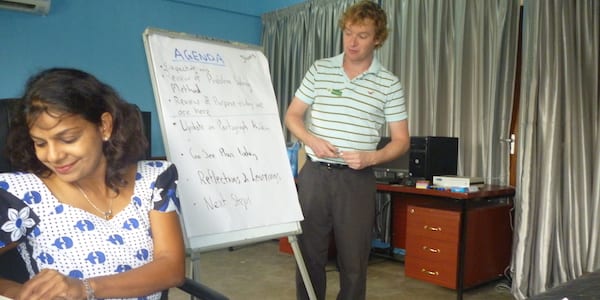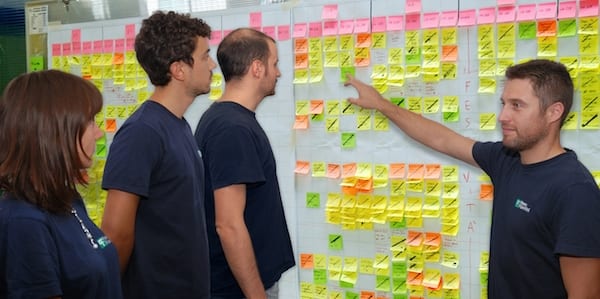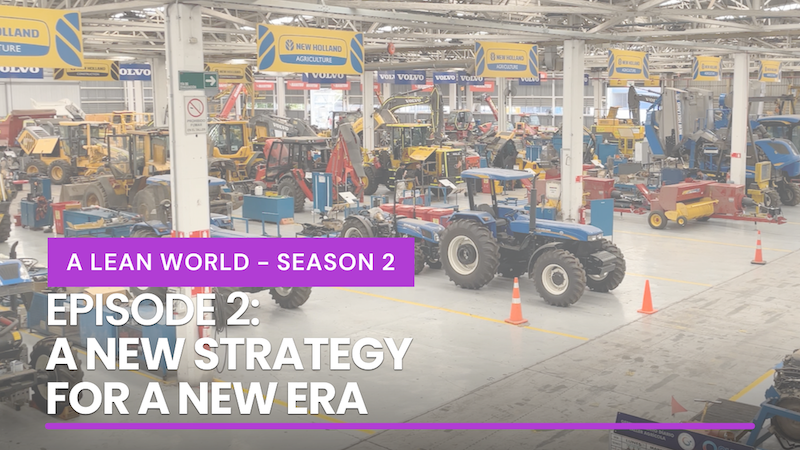
Good lean coaching comes from caring for those we mentor
FEATURE – What makes a mentor-mentee relationship successful? This intimate account comes all of the way from a Tanzania healthcare organization, and proves how lean is fundamentally about “caring for people.”
Words: Brenda D’mello, doctor at Comprehensive Community Based Rehabilitation in Tanzania (CCBRT), Dar es Salaam; Mike Grogan, lean coach.
This is the story of the working relationship between a mentor and a mentee. We passionately believe that the principles and approaches discussed here are applicable to all educator-learner relationships, whose goal is to see the learner grow and realize their potential. If you are actively developing someone today, will be developing someone in the future or simply want to further develop yourself, this article will provide you with valuable insight on how to succeed.
Mike: It is estimated that 154 women die in Tanzania every week due to improper care during childbirth. With the national healthcare system completely overwhelmed (paralyzed, in fact), the services provided by not-for-profit organizations represent for many people the only chance to relieve pain and, often, survive. Dar es Salaam-based Comprehensive Community Based Rehabilition in Tanzania (CCBRT) is one of these organizations.

CCBRT was founded 20 years ago to pursue the vision of a Tanzania where people have access to quality disability services as well as safe maternal and newborn care. Since then, it has grown to become Tanzania’s largest indigenous provider of disability services: over the years, millions of Tanzanians (some of which are the poorest and most marginalized people in the world) have been positively impacted - directly or indirectly - by CCBRT’s work.
The 450 people working for the organization continuously strive to remove as many barriers as possible to allow more people to access quality care. Part of this effort is without a doubt the lean journey CCBRT embarked on in 2013 (the organization is still one of the few examples of lean applied to healthcare in the developing world), when I was hired as a full-time lean coach.
I had visited Tanzania as a tourist in 2010, and was determined to return and somehow make an impact on the heart-breaking poverty I had witnessed. In November 2011, I volunteered to introduce CCBRT leaders to basic lean ideas, an experience that changed my life forever. I fell in love with CCBRT, its mission and its people. After another volunteer experience in 2012, I finally joined the organization full-time in February 2013.
Among the organization’s leaders I taught, one really stood out and quickly became one of my favourite people. I have never come across anyone more passionate about a mission than Dr Brenda D’mello. What a joy it was to work with her: Today I consider Brenda to be CCBRT’s most advanced lean leader.
Brenda: I was blessed with a father who wanted his daughters to be independent and have options in life, but outside the house I did not receive the same treatment: in medical school in the mid-1980s I remember being ignored when I asked a question or even when I answered one (a professor once asked me if I didn’t have anything more important to do in life, like find a husband and make babies). The tenacity to withstand this kind of behavior certainly made me stronger.
When I got my degree in Obstetrics/Gynecology in 1999, my father sent me a card saying how proud he was. I knew that he hoped I would go on to help and serve other women.
I quickly learned that women in developing countries tend to be disempowered, which is what in turn makes them vulnerable. Instead, women need a voice, and someone who cares about them. When they have these things, there is no limit to what they can achieve.
This message further resonated with me when, years ago, I had the pleasure of briefly meeting Mother Theresa, who looked into my eyes and told me the world needed more doctors who care. I have always admired her and her way of elevating even the smallest of deeds, so long as it is performed with love. I have always interpreted this as a way of saying that it is better to do small things than to do nothing, that there is no such thing as a meaningless contribution to bettering people’s lives.
I have led CCBRT’s Maternal Healthcare capacity building project since 2010. Together with the local authorities, my team has designed and implemented a capacity building initiative targeting 22 of Dar es Salaam’s busiest public labour wards, performing more than 105,000 deliveries across 22 facilities in 2014.Tragically, however, at least 10 babies under the age of one week die every day due to complications at childbirth in the city.
I often felt like my contribution could only be a drop in an ocean of need, but as Mother Theresa said, “We ourselves feel that what we are doing is just a drop in the ocean. But the ocean would be less because of that missing drop.” Today, I am grateful for having a job that allows me to provide for my children (their father passed away eight years ago) while contributing to society. Thanks to Mike’s mentoring and to lean thinking, my work can now help more people more effectively.
HOW THE TIME WAS SPENT TOGETHER
Mike: In my two years at CCBRT, I have spent approximately 80 to 120 hours working with Brenda. Sometimes we would spend one hour a week together, other times it would only be 10 minutes. We had no fixed schedule, but running workshops or visiting public hospitals together normally allowed us to spend a full day in each other’s company.
The mentoring took many approaches, from observing her with her team to facilitating workshops together, from going to see together (we went to many maternity units) to discussing a pressing problem face to face (Brenda would then go on and try to address the issue- after that, we’d have a follow-up session).
LESSONS LEARNED

Brenda: I learned a lot from Mike and the many hours of conversation we have had: face-to-face problem solving, managing conflict resolution, how to prepare for major workshops, and how to “go see.” Mike saw opportunities everywhere, but never told me how I could improve – instead, he ensured I too saw those possibilities. And he asked me, “What is the one thing I can help you with?” Many of the sentences I regularly use these days can be linked back to the time I spent being mentored by Mike: “What is the standard?” “99% of the problem is the system, not the people,” “Ask the people what they think the solution is,” “Understanding the ‘why’ is the most important part of change.”
He mentored me in a number of different ways. One day he would should me an inspiring Youtube video, the next he would bring me a book on lean (some of which I found a bit difficult as I am not too familiar with the jargon).
Mike was like a sounding board for ideas (we both had a notepad with us, on and off campus) and is great at asking questions that make you think deeply and help you to find answers that make you grow. However, I have to admit that it was frustrating at times, especially when Mike would not give me an answer or “just tell me” how to make things better. I failed to see it at the time, but what he was doing was forcing me to dig deeper into problems. The best was when I finally got it… sometimes a couple of days later.
THE RESULTS (VISIBLE AND INVISIBLE)
Brenda: Thanks to Mike’s input I have seen significant improvements in the areas that I am responsible for. Some of the most noteworthy are listed below.
- The introduction of the Activity Tracking board helps with anything from planning to donor reporting. Last year CBBRT carried out more than 88 distinct activities (including in-service training in Emergency obstetric care, neonatal care, surgical skills, anaesthesia followed by on-the-job coaching and mentoring, and so on), and we can now tell right away which of our three donors funded what, and the outcome and cost of each activity. Subsequently, costing is much more accurate.
- Our Procurement Tracking initiative outlines the entire procurement process from start to finish on a board. It includes a weekly review and follow-up planning by representatives from procurement, program management, and finance. In 2013 there were more than 15 orders for essential equipment and supplies carried over, and the program manager ended up spending several hours in procurement with no one knowing where the process was stuck, which led to a delay in annual reporting and audits. In 2014, the 137 orders requested were closed on time except for one, which was cancelled.
- We are having difficulty tracking referrals from sites supported by our community program to the disability hospital and the database at Disability Hospital is not very user-friendly. The Monitoring&Evaluation officer I am mentoring as a leader reassured me he was going to coordinate a group of managers to understand the problem, define the “steps” and then together start the problem solving process so that the problem would not reoccur this year. The terms he used and his thinking made me smile and remember Mike’s lessons. I haven't got the solution yet, but I know the people who do the job will come up with a great one. Come back next year and you’ll see!
- A more difficult result to measure is the great pleasure and satisfaction I get from hearing a health facility manager say things like, “We will do a 'go see'” This is the beginning of the end of the blame culture at CCBRT, and a management revolution in the making.

As relevant as these improvements are, however, I think that the biggest impact Mike had was on my way of thinking, in particular on my approach to management and leadership. Getting out of my comfort zone in the way I manage and lead my team was really challenging at first. Mike’s method - understand it, make it visual, encourage solutions from the bottom up, constantly reflect on it, improve it - is an easy sell (it makes perfect sense) but is easier said than done. It is hard work for a manager (you can never say you are done improving) but also incredibly humbling.
I often had Mike attend our team meetings and give me feedback, and I told everybody that I was trying to improve. What a great moment that was… of course not as great as when I went through the two pages of notes on how to improve I got from Mike.
After my end-of-year team workshop, I had a 1-1 meeting with every member of the team. Some of them had been with the company for 14 years, others for much less. But they all gave me excellent feedback, saying that that had been the year in which they had grown the most as people and professionals. I am proud of the system we have developed as a team.
WHAT MADE THE RELATIONSHIP WORK
Mike: Brenda was eager to learn and very humble long before I met her, and I believe these are the two most important attributes a leader should have. These traits made her a joy to work with. She recognized that she would have to change herself before she could change the environment around her. Her attitude towards self-development and experimentation was extraordinarily proactive. Combined with her drive, comin from her care for the mission and the people who are trying to execute it, made mentoring Brenda the proudest achievement of my career.
Brenda: Mike’s personality is one of his best traits. I felt he genuinely cared for my work and the people I was trying to serve. In one instance, he and I delivered a four-day problem-solving workshop for 30 senior maternal healthcare managers from the Dar es Salaam Region, and Mike had an extraordinary impact on them. This is no easy task in a room full of Swahili native speakers with lots of power and used to having an almost autocratic leadership style. They even invited him to go see the hospitals that they were responsible for, something that a normal visitor to the region would not get to see. Like me, they sensed that this guy genuinely did care and was here to help.
Mike: I am convinced that I have learned more from Brenda than she has from me. We certainly grew together. I truly do care for her, and nothing makes me prouder than to see her further develop as a leader, realize her potential, and make a difference in the lives of so many women and children in this community.
Need further proof of how far she has gone? At the end of a five-day visit to CCBRT, John Toussaint (CEO of the Thedacare Centre for Healthcare Value and one of the world’s leading voices in lean healthcare) sat down with CEO Erwin Telemans and shared with him his observations on the “state of lean” in the organization. When asked by Erwin for a piece of advice on how to keep growing the organization, John replied: “How can we make more Dr. Brendas?” He had only spent 15 minutes talking with her.
Brenda: Even one person can make a difference, if they truly care. My life is forever changed because I met Mike. He has opened my eyes to the improvement possibilities I have and started me on a journey. Now it is up to me to keep developing myself.
I can see huge potential for this kind of thinking, which I believe could really make a big impact in low-resource countries that have almost lost all hope, are blighted by waste and are characterized by a leadership style based on a culture of blame, rather than on the idea of respect for people.
WHY THIS MESSAGE APPLIES TO ALL OF YOU
Theodore Roosevelt once said: “People don’t care how much you know until they know how much you care.” And this is the main message of this article: you must show that you care. Without this, there will be no breakthrough results. If you stop for a minute and reflect on the people in your life that have had a significant and positive income on your development, the common denominator for all of them is likely to be that you knew how deeply they cared about you. When you sense that another person cares about you a strong connection is made, through which knowledge and wisdom can be transferred smoothly.
Not only is this the foundation of a transformation, but it is also applicable to all relationships in life. Whether you are a parent, teacher, instructor, advisor, sister, brother, coach or friend, you should embrace the challenge of figuring out how to show the person you want to develop that you deeply care about them.
It is never too late to reflect on our approach to our current and future relationships, and to express to others that we care for them and their development. This will lead to significant results and will ensure you leave a legacy behind you. In the words of Mother Theresa, “It’s not how much we give, it’s how much love we put into giving.”
THE AUTHORS


Read more


NOTES FROM THE VIRTUAL GEMBA – Despite a 40% drop in sales and the looming prospect of having to furlough part of its staff, this French company is finding in lean manufacturing an ally to fight the current crisis.



INTERVIEW - Anton Ulanov is the CEO of one of the largest agricultural businesses in Russia. He talks with PL about the application of lean at Agroholding Kuban, discussing the wider challenges and opportunities for lean in agriculture.


CASE STUDY – A unique approach to lean management and the involvement of CEO Mario Nardi helped Pietro Fiorentini, provider of solutions for natural gas distribution, become a model for lean companies in Italy.


WEB SERIES – In the second episode of our docuseries on lean in Chile, we learn how, with a clear purpose and strong commitment from leadership, SKC is transforming its processes and mindset and building a competitive advantage.

